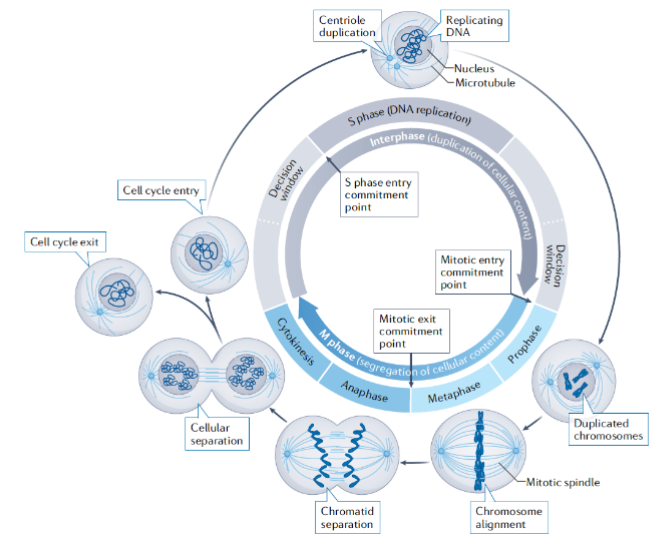Cell Cycle
1/39
There's no tags or description
Looks like no tags are added yet.
Name | Mastery | Learn | Test | Matching | Spaced |
|---|
No study sessions yet.
40 Terms
Cells must accomplish what two basic things during the cell cycle
Copying cellular components
Dividing the cell so that components are distributed evenly to the daughter cells
What is meant by the “cell cycle”?
The alternating growth and division activities of a cell.
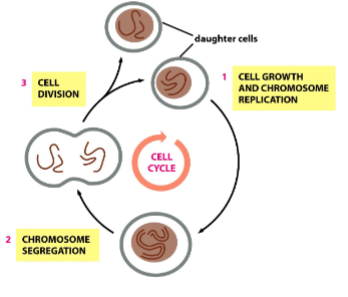
Which phase corresponds to cell growth
Interphase
Which phase corresponds to cell division?
M phase.
What technology allows us to distinguish cancer cells under the microscope compared to normal cells?

What model organisms are used in genetics to study the cell cycle?
Fission yeast (Schizosaccharomyces pombe) and budding yeast (Saccharomyces cerevisiae).
What systems are used in biochemical studies of the cell cycle?
Sea urchin eggs, starfish eggs, and frog eggs.
How can budding yeast be used to study the cell cycle?
Different morphological forms (budding stages) correspond to different phases of the cell cycle, making progression visible.
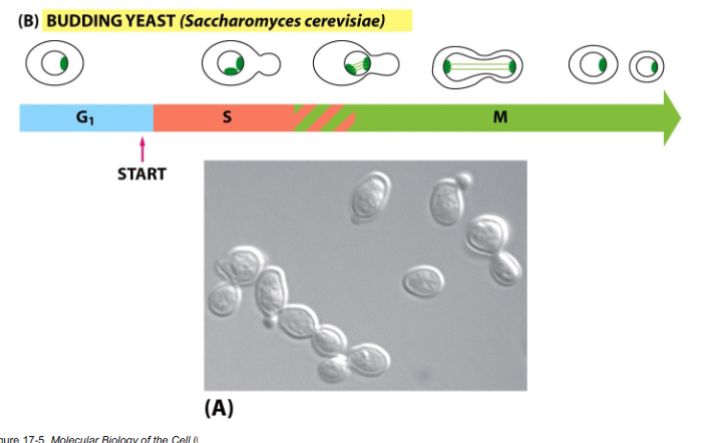
What are CDC genes?
cell division cycle (CDC) genes - Genes that control progression through the cell division cycle.
How were CDC genes identified?
CDC (cell division cycle) genes were discovered in yeast through temperature-sensitive mutants.
At normal temperature, these mutant yeast cells could divide normally.
At restrictive (higher) temperature, the mutant CDC gene product misfolded or lost function.
This caused the cells to arrest at a G1 of the cell cycle
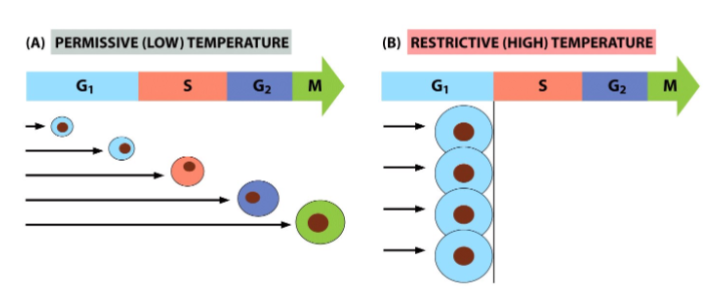
What is the outcome of cell cycle misregulation?
Tumor growth (uncontrolled cell division).
What happens in G1 phase?
Cell growth, duplication of components, prep for replication, G1 checkpoint (decision to divide or exit).
What happens in S phase?
DNA replication + centrosome duplication.
centrosome location & role
The centrosome is located near the nucleus of the cell and contains the microtubule organizing center MTOC in animal cells. It contains two centrioles that migrate to the poles before cell division and serve to organize the spindle.
What happens in G2 phase
Cell growth, checkpoint for entry into M phase.
What happens in M phase?
Mitosis (prophase → prometaphase → metaphase → anaphase → telophase) + cytokinesis.
What key event happens in prophase?
Chromosome condensation
Mitotic spindle forms
Centrosomes separate
Histones are modified
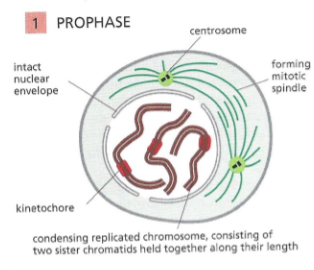
What is required for the condensing of chromosomes in prophase to occur
Condensin
DNA topoisomerase II
What key events happen in prometaphase?
Nuclear envelope breakdown
Chromosomes attach to the spindle microtubules via their kinetochores to initiate bipolar orientation
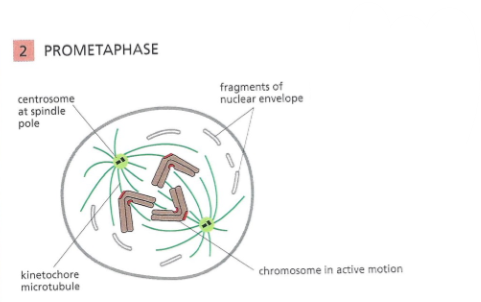
What happens in metaphase?
Chromosomes align at metaphase plate (equator)(midway between spindle poles)
Kinetochore microtubules attach sister chromatids to opposite poles
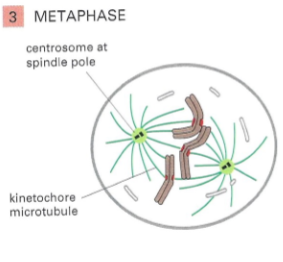
What happens in anaphase?
Sister chromatids separate and move to poles. (how? microtubules get shorter & poles move apart)
The nuclear envelope begins to reassemble
The metaphase-anaphase is tightly regulated!
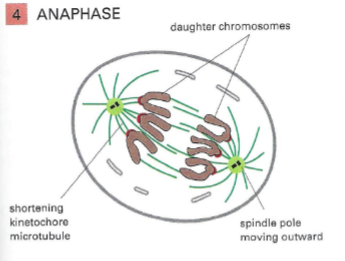
What happens in telophase?
Chromosomes keep moving towards the poles
Nuclear envelope reassembles around the sets of daughter chromosomes (/sister chromatids check this! says 2 different things in notes) at each pole - this completes the formation of the 2 nuclei.
The cleavage plane is specified & the contractile ring begins contracting to divide the cytoplasm
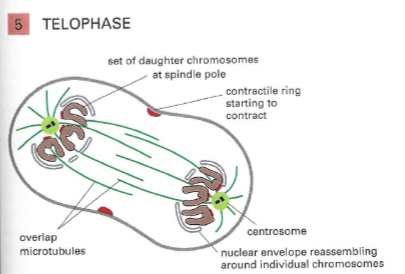
What happens in cytokinesis?
Contractile ring made of actin & myosin separates the 2 daughter cells
Chromosomes decondense & nuclear structures reform
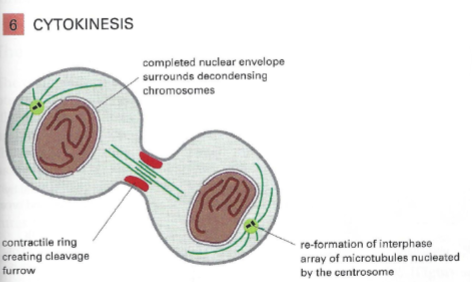
What is a kinase
Enzymes that add a phosphate group (phosphorylate) to other proteins (substrates) thus affecting their function
What is a phosphatase
Enzymes that remove phosphate group from other phosphorylated proteins
What are cyclin-dependent kinases (CDKs)?
Protein kinases with a catalytic domain that require binding to cyclins to become active.
Do CDK levels fluctuate during the cell cycle?
No — CDK protein levels remain constant throughout the cell cycle.
What are cyclins?
Regulatory proteins whose levels rise and fall during the cell cycle, controlling CDK activity.
How do cyclins regulate CDKs?
Cyclins bind to CDKs, activating them to phosphorylate proteins that initiate or regulate cell cycle processes.
Which cyclin-CDK complexes are active in G1 phase?
Cyclin D–CDK4
Cyclin D–CDK6
Cyclin E–CDK2.
Which complexes are active in S phase?
Cyclin E–CDK2
Cyclin A–CDK2.
Which complexes are active in G2 phase?
Cyclin A–CDK1
Cyclin A–CDK2.
Which complexes regulate mitosis?
Cyclin A–CDK1
Cyclin B–CDK1 (MPF, “Mitosis-Promoting Factor”).
What two steps are required for CDK activation?
Binding of a cyclin.
Phosphorylation of the CDK activation loop by CDK-activating kinases (CAKs).
What are the two main mechanisms of CDK inhibition?
Inhibitory phosphorylation (by Wee kinases)
Binding of CDK inhibitors (CKIs) — small proteins that block CDK activity.
What reverses inhibition of CDKs by inhibitory phosphorylation by Wee kinases
CDC25 phosphatases
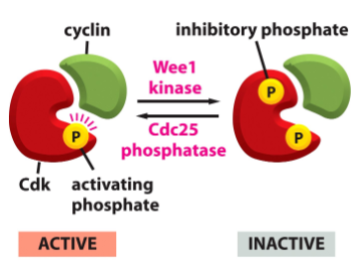
Name a small protein that inhibits CDKs
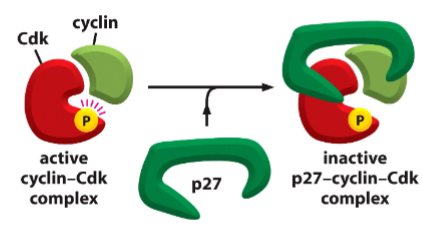
How are cyclins removed from the cell cycle once their job is done?
By ubiquitin-mediated proteasomal degradation.
Which cellular system carries out cyclin degradation?
The ubiquitin-proteasome system, tagging cyclins with ubiquitin chains for destruction
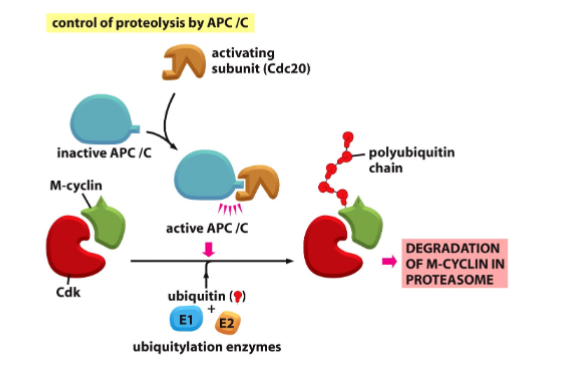
Diagram of cell cycle
